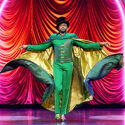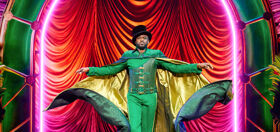Long before Lady Gaga shocked the world (and Leo DiCaprio) by winning a Golden Globe for her ghoulish turn in American Horror Story: Hotel, there were other leading ladies who inspired a whole generation. It may be hard for many of us today to understand the particular appeal of the psycho biddy films of the 1960s among the LGBT community, but the undeniable fact remains. As far back as the early 1950s, actresses such as Bette Davis and Joan Crawford were known as established gay icons. The writer of a 1953 magazine article entitled “The Cult of Bette and Joan” stated that “Miss Davis and Miss Crawford mirror certain frenzied, posturing, arrogant, prima donna-ish, ego-deifying, self-projecting, super-compensating principles that psychologists have spotted in the more aggressive and flamboyant homosexuals.” This derogatory attitude would continue, and in an uncanny conjuncture, the fears and anxieties faced by the aging female stars of the Golden Age, who found themselves on the margins of Hollywood’s youth obsessed system, mirrored the social exclusion felt by many in the LGBT community.
 The genre known as psycho biddy, also referred to as Grand Dame Guignol, was officially born with the 1962 release of Whatever Happened to Baby Jane?, which famously starred both Davis and Crawford. Against all odds the film became a huge box office success, also gaining substantial critical praise and an Oscar nomination for Davis. The film triggered an important and often overlooked sub-genre of horror, which gave numerous middle aged actresses a chance for second career in an industry where women beyond the age of 40 were rarely given a voice. By attacking their parts with fierce determination to succeed and prove their continued relevance, these ladies created highly-charged, charismatic and restless characters, who often rebelled against the rules imposed by society. The films of Grand Dame Guignol were often violent and grotesque, which has prompted certain critics to brand them as ‘hagsploitation’ movies, and yet they can also be read as a passionate, if indirect, expression of rebellion against the reductive view of aging, and the sexist and misogynist standards of patriarchal society. It is therefore unsurprising that, while often ignored by mainstream critics, the genre was embraced by the LGBT community. Coinciding with the growing sense of unrest and the desire to be heard, the psycho biddy films managed to appeal to the gay community’s sense of outrage, which was brewing under the surface. The larger-than-life heroines of Grand Dame Guignol faced society’s scrutiny without the protective armor of marriage or motherhood, often indulging in excess and eccentricity, symbolizing survival and flamboyant rebellion, thereby inadvertently gaining cult following among the gay community. Over the years, this has also been reflected in an overwhelming number of parodies by drag artists, who used the iconic heroines of the psycho biddy horrors as an inspiration.
The genre known as psycho biddy, also referred to as Grand Dame Guignol, was officially born with the 1962 release of Whatever Happened to Baby Jane?, which famously starred both Davis and Crawford. Against all odds the film became a huge box office success, also gaining substantial critical praise and an Oscar nomination for Davis. The film triggered an important and often overlooked sub-genre of horror, which gave numerous middle aged actresses a chance for second career in an industry where women beyond the age of 40 were rarely given a voice. By attacking their parts with fierce determination to succeed and prove their continued relevance, these ladies created highly-charged, charismatic and restless characters, who often rebelled against the rules imposed by society. The films of Grand Dame Guignol were often violent and grotesque, which has prompted certain critics to brand them as ‘hagsploitation’ movies, and yet they can also be read as a passionate, if indirect, expression of rebellion against the reductive view of aging, and the sexist and misogynist standards of patriarchal society. It is therefore unsurprising that, while often ignored by mainstream critics, the genre was embraced by the LGBT community. Coinciding with the growing sense of unrest and the desire to be heard, the psycho biddy films managed to appeal to the gay community’s sense of outrage, which was brewing under the surface. The larger-than-life heroines of Grand Dame Guignol faced society’s scrutiny without the protective armor of marriage or motherhood, often indulging in excess and eccentricity, symbolizing survival and flamboyant rebellion, thereby inadvertently gaining cult following among the gay community. Over the years, this has also been reflected in an overwhelming number of parodies by drag artists, who used the iconic heroines of the psycho biddy horrors as an inspiration.
If you wish to immerse yourself in this unique genre and feel empowered by these outrageous Grand Dames, below are the essential titles you should start with. Fasten your seatbelts!
Although not officially part of the genre, these three films can be seen as direct predecessors of what was to come, not that anyone ever really needs an excuse to re-visit these classics.
How about we take this to the next level?
Our newsletter is like a refreshing cocktail (or mocktail) of LGBTQ+ entertainment and pop culture, served up with a side of eye-candy.
Sunset Boulevard, 1950
Norma Desmond, played by Gloria Swanson can be seen as the fairy godmother of the psycho biddies of the ’60s; desperately clinging to the memory of a glorious past as a silent movie queen, she becomes obsessed with a young writer (and who can blame her — it’s William Holden!), and in the gothic tradition of the vampire, tries to drain him of his youth and beauty.
All About Eve, 1950
Bette Davis as the aging stage diva Margo Channing is a sensation, her performance as powerful today as it must have appeared in 1950. Although Davis was only 42 when she made the film, her age becomes the main focus of the narrative: how does an aging actress go back to being a woman?
 Suddenly, Last Summer, 1959
Suddenly, Last Summer, 1959
This might just be the most twisted adaptation of a Tennessee Williams play ever, with a ghostly presence of a dead gay poet Sebastian, eaten alive by young Spanish cannibals, hovering over the entire narrative. The duel between the youthful and stunning Elizabeth Taylor and the sinister, eccentric Katharine Hepburn is a thing to behold. Hepburn’s nuanced performance transforms her character from what could have easily become a monstrous portrayal of archetypal bad matriarch to a more complex, at times even sympathetic character.
Okay, now you’re ready for the real thing.
Whatever Happened to Baby Jane? 1962
Welcome to a world populated by haunting memories, unrealized ambitions and crippling loneliness. All these are personified by the two sisters; Baby Jane and Blanche Hudson. The idea that a mainstream film would star two middle-aged actresses was revolutionary in 1962, and four main Hollywood studios declined to even read the script or scan the budget, before Seven Arts, a small independent company, decided to take a gamble. The result is one of the most iconic movies of the 1960s, and a start to what would become a significant genre. Davis and Crawford, who famously hated each other in real life, are both outstanding — creepy doesn’t even begin to describe their antics. Oh. And one more thing. We have rats in the cellar…
Hush…Hush, Sweet Charlotte, 1964
This film, also directed by Robert Aldrich, was clearly designed to capitalize on the successful formula created by Whatever Happened to Baby Jane? Originally set to reunite Davis and Crawford, Joan eventually left the production unable to cope with Davis’ hostility. Olivia de Havilland, brought in to replace Crawford, turned out to be the perfect match for Davis. This Southern odyssey of horror is just as stunning as it is horrifying, and if nothing else, it is a must-see for the terrifying transformation of de Havilland, who starts off with all the sweetness of Melanie from Gone with the Wind, only to out-Davis Davis in her psycho biddy fabulousness by the end. And you will creep yourself out by humming the theme song for days.
What Ever Happened to Aunt Alice? 1969
Released in the same year in which the Stonewall riots took place, this is the least known but perhaps the most brilliant of the Aldrich trilogy, with Geraldine Page’s extraordinary performance, containing what one critic described as moments of ‘inspired madness’, representing the quintessential Grand Dame of the genre. Her highly mannered, over-the-top portrayal manages to shift the focus away from the fact that she is a psychopathic murderess, instead creating an atmosphere of indulgent, decadent campness. The incredible chemistry between Page and Ruth Gordon (just fresh off her unforgettable, Oscar winning role as Minnie Castevet in Rosemary’s Baby and before her titular septuagenarian lover in Harold and Maude) makes this movie a true gem.
The Nanny, 1965
Davis strikes once more, and thanks to the popularity of the two Aldrich films, she is by now, along with Crawford, the queen of hag horror. This is a stylish chiller, set in Swinging London, with Davis once again playing a morally ambiguous character; this time a mentally disturbed nanny, whose own traumas related to motherly guilt transform her from a loving carer to a maniacal murderess. You may never want to take a bath again.
Strait Jacket, 1964
This film can be seen as a quintessential example of the hagsploitation aspect of the genre, taking full advantage of the macabre iconography of the psycho biddy. Strait Jacket was heavily promoted to exploit its supposedly graphic depiction of gruesome violence, although in reality the obvious use of models and mannequins makes it impossible for the viewer to ever be truly horrified. However, Crawford’s performance and the psychological complexity of her character makes this an interesting exploration of aging and motherhood, as well as a valid self-reflection on her own star image.
https://www.youtube.com/watch?v=AcDUntyspTM
What’s the Matter with Helen? 1971
As the 1960s drew to a close, the psycho biddy genre slowly begun to fade away, with a few notable films still appearing into the ’70s. This macabre tour de force from Shelley Winters and Debbie Reynolds, set in the Depression-era L.A., is one of the most noteworthy of the late psycho biddies. Borrowing heavily from its predecessors in terms of narrative and visual iconography, the film is also influenced by the American New Wave films, such as Bonnie and Clyde and Butch Cassidy and the Sundance Kid, demonstrating that the leading ladies from the golden days of Hollywood weren’t afraid to move with the times.
Night Watch, 1974
When one thinks of Elizabeth Taylor, images of glamour and beauty come to mind; a glorious Cleopatra or perhaps the tantalizing Maggie from Cat on a Hot Tin Roof. This forgotten horror is a far cry from her MGM days, casting Taylor as screaming harpy-wife, in a narrative filled with violence, marital infidelities and ruthless scheming (and no, it isn’t a home video from the Taylor and Burton household). The timing of the film is doubly poignant; a swan song for both the psycho biddy genre and Taylor’s movie career.























Desert Boy
Hag horror? HAHAHAHAHAHAHA. Never heard that description for American Gothic before.
Glücklich
what the fuck’s up with this comments section? buggy as all get out!
Christopher Hayward
Suddenly Last Summer.
Manknee Aeizona
https://youtu.be/pATL6rPbpvY
RomanHans
Really nice, intelligent, interesting piece. Thanks!
He BGB
I have been aware of tge Horror hag genre since it appeared in issues of Scarlet Street. There are more films like The Killing Kind Ann Sothern, how awful about allan, with Anthony Perkins and Julie Harris. Sandy Dennis in That V cold Day in the Park. Another Crawford I saw what you did. Crawford always looking like the great movie star dressed to The nines. And others if you can get your hands on those Scarlet Streets.
He BGB
I have been aware of the Horror hag genre since it appeared in issues of Scarlet Street. There are more films like The Killing Kind Ann Sothern, how awful about allan, with Anthony Perkins and Julie Harris. Sandy Dennis in That V cold Day in the Park. Another Crawford I saw what you did. Crawford always looking like the great movie star dressed to The nines. And others if you can get your hands on those Scarlet Streets. Check out The Anniversary with Bette Davis, Ruby with Piper Laurie, the mother in Carrie and also the last film of veronica Lake Flesh Feast
He BGB
Also, Ruby Piper Laurie of Carrie fame, The Anniversary another bizarre Bette Davis, and Veronica Lakes last stinker The Flesh Feast
sfcarlos65
The scene in “Straight Jacket” where Joan Crawford eye rapes her daughter’s boyfriend has to seen to be be believed.
Cobalt Blue
I loved to read this. Never had known about ” Grand Dame Guignol “. Very enlightening indeed. Thanks.
Will G
Glaring omission:
“Die! Die! My Darling!” (1965) starring none other than Tallulah Bankhead.
martinbakman
https://youtu.be/F0Vj3zLaO4w
dvlaries
Jane earned back its entire production costs in less than a week of release.
*
Davis decided that Jane Hudson never washed her face but only applied a new layer of makeup each day. When told, a who’s-who of Hollywood makeup men ran the other way, claiming they’d never work again if they ‘did that‘ to Bette Davis, so she did her own makeup.
*
But not every battle Davis won was one she remained pleased about. At an early screening she attended with Aldrich, and her choice over two stories high in front her, the director soon heard Bette quietly sobbing. “Did I really look that bad?”
bottom250
They are such fabulous movies I love them all.
Bauhaus
@Glücklich:
Full Moon.
My grandmother used to sit me down on Saturday afternoons in the 70s, and we’d watch these movies for hours on end.
Fasten Your Seatbelt:
https://m.youtube.com/watch?v=yKHUGvde7KU